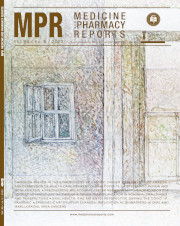The impact of oral anticoagulants on the characteristics of subdural hematomas and other brain lesions in patients with traumatic brain injury
DOI:
https://doi.org/10.15386/mpr-2535Keywords:
anticoagulants, coagulation status, subdural hematoma, brain trauma, preoperative computed tomographyAbstract
Background and aim. The aim of the study was to determine the impact of prior anticoagulant treatment on the characteristics of intracranial hematomas.
Methods. We included in this retrospective study 135 patients who were diagnosed with subdural hematoma in the context of traumatic brain injury. We recorded the demographic and clinical data, the paraclinical examinations and the characteristics of subdural hematoma evidenced by preoperative computed tomography (CT). We also reported the other brain injuries, entailed by primary and secondary lesions, as described by CT.
Results. The anticoagulation therapy was recorded in 35 patients, at the moment of diagnosis. Acute subdural hematoma was recorded in 89 (65.9%) patients, 21 (60%) of these had anticoagulation therapy on admission. There were 46 (34.1%) patients with chronic subdural hematoma, 14 (40%) of these were on anticoagulant
therapy. The midline shift was significantly moved in patients with anticoagulation therapy. The thickness of the subdural hematoma was significantly higher in patients with anticoagulation. We did not find any significant association of the other brain lesions (cranial fracture, extradural hematoma, intraparenchymal hematoma, nor
intracranial hypertension, brain herniation, brain swelling), and the presence of anticoagulation therapy.
Conclusion. The study showed that anticoagulants significantly influence some neuroimaging aspects of the SDH in head trauma.
Downloads
Published
How to Cite
Issue
Section
License
The authors are required to transfer the copyright of the published paper to the journal. This is done by agreeing to sign the Copyright Assignment Form. Whenever the case, authors are also required to send permissions to reproduce material (such as illustrations) from the copyright holder.

The papers published in the journal are licensed under a Creative Commons Attribution-NonCommercial-NoDerivatives 4.0 International License.

